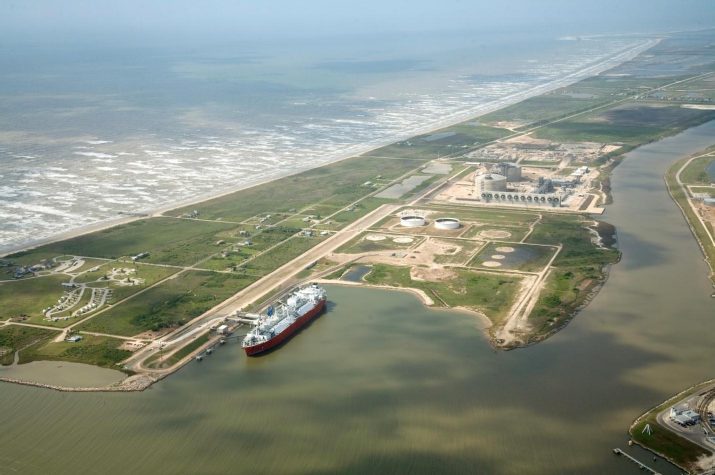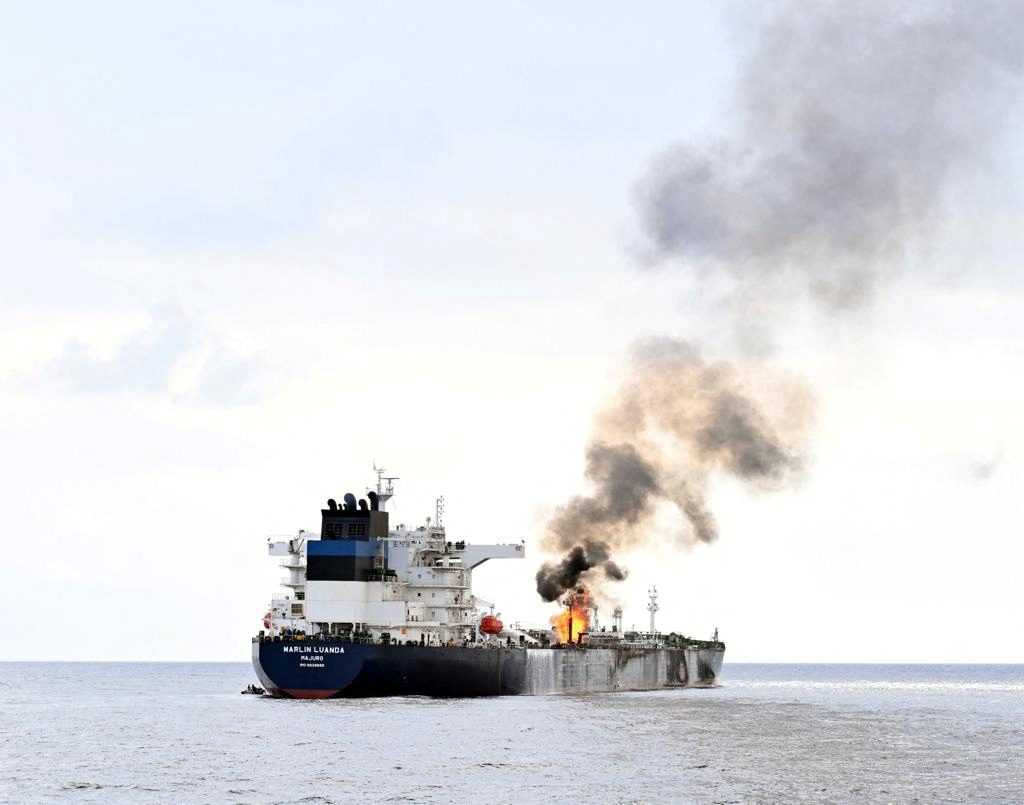Freeport LNG terminal on Quintana Island, about 70 miles south of Houston, Texas. Photo: Freeport LNG
By John Kemp
LONDON, Sept 13 (Reuters) – Large-scale gas exports from the United States will narrow the gap between U.S. domestic prices and those in Asia, but the boost to U.S. domestic gas prices is likely to be smaller than U.S. gas producers hope and consumers fear.
In October, gas importers in Japan and Korea will pay more than $15 per million British thermal units for shipments of liquefied natural gas (LNG), compared with under $10 for importers in Britain and less than $4 for importers in the United States, according to the U.S. Federal Energy Regulatory Commission.
No wonder gas producers and traders want to exploit the arbitrage, buying gas in the United States at prices linked to Henry Hub (currently under $4), liquefying it, and exporting it to customers in Japan, Korea, China and India at formula prices linked to the Japan Crude Cocktail (which currently values gas at more than $15).
For their part, Asian buyers want to break the oil link and purchase LNG at lower prices closer to Henry Hub. And domestic gas consumers in the United States fear that once exporting starts in earnest they could see the price they pay for natural gas double or more as American and Asian converge.
The problem with all these hopes and fears is that they fail to account properly for the enormous costs of running an LNG operation.
LNG prices in Asia are very unlikely to fall anywhere near to the level prevailing in the United States because exporters have to recover the enormous capital and operating costs of liquefying and transporting the gas.
Conversely, domestic U.S. gas prices will not rise anywhere close to those in Asia because the arbitrage window would close long before they approached that level.
EXPENSIVE BUSINESS
In a series of careful economic studies, Emil Attanasi and Philip Freeman of the U.S. Geological Survey estimated liquefaction and transportation costs from a hypothetical plant on the southern coast of Alaska to Yokohama in Japan.
Costs would range from $6 to $10 per million British thermal units, depending on how much the gas could be bought for originally and the project’s assumed rate of return, according to Attanasi and Freeman (“Commercial possibilities for stranded conventional gas from Alaska’s North Slope” June 2013).
If gas could be purchased in Alaska for $4 per million BTU, treated and piped across the state for another $3-4, it would still need to be sold in Yokohama for between $14 and $19, depending on whether the project tried to achieve a rate of return of 9 percent or 15 percent.
In practice, LNG exported from facilities along the U.S. Gulf Coast and Atlantic seaboard would be cheaper. Unlike Alaska, projects would be able to use the existing gas transmission network. No new pipelines would need to be built to transport gas to the liquefaction facilities.
Many of the most advanced export LNG projects are being constructed at locations along the U.S. Gulf and Atlantic Coasts that were originally built to import LNG. Much of the infrastructure, including storage tanks and deepwater berths, can be re-used, slashing the overall capital costs.
By avoiding the cost of new pipelines and re-using storage tanks and berths, U.S. LNG exporters may be able to cut delivered costs to Japan by $3-4 per million BTU.
Even so, it is hard to see how LNG could be delivered from the United States to Japan for less than $10 per million BTU.
Conversely, it is hard to see how LNG exporters could afford to buy gas in the United States for more than $6 and still hope to make money.
FOREIGN COMPETITION
The United States is not the only country hoping to supply more gas to fast-growing markets in East and South Asia.
China could acquire substantial quantities of pipeline gas from Russia and Central Asia for a delivered price in Shanghai of $7-11 per million BTU, according to an evaluation of alternative supplies by Attanasi and Freeman (“Meeting Asia’s future gas import demand with stranded natural gas from Central Asia, Russia, Southeast Asia and Australia” March 2015).
China, Japan, South Korea and India will also be able to obtain large volumes of LNG from Australia, Malaysia and Indonesia for landed prices ranging from $9-14 per million BTU.
With so many potential rival suppliers in the Asia market, U.S. LNG will need to be delivered to Asian ports at prices no more than $14, and perhaps less than $12.
In those circumstances, the netback price at the point of export in the United States is unlikely to exceed $6 or $7 per million BTU.
In its study for the U.S. Department of Energy, NERA Economic Consulting reached a similar conclusion. NERA predicted exports would push future domestic gas prices up to around $4 and $8 in real terms, with most scenarios putting gas price around $6 (“Macroeconomic Impacts of LNG Exports from the United States” Dec 2012).
ALASKA’S NORTH SLOPE
Interest in LNG exports continues to pick up. On Thursday, Alaska’s Natural Resources Commissioner Dan Sullivan announced the state had signed a memorandum of understanding with Japan’s Bank for International Cooperation (JBIC) to explore a number of natural resource projects, including LNG exports.
Alaska’s North Slope oilfields contain roughly 35 trillion cubic feet of stranded gas. TransCanada, ConocoPhillips , BP and Exxon Mobil are jointly studying a possible LNG project to monetise it by building a pipeline across the state and a liquefaction facility on the south coast that would send cargoes Asia.
Evaluating the project, however, Attanasi and Freeman warned: “Alaska’s gas exports to Asia will likely encounter substantial competitive pressures.”
Even if stranded North Slope gas could be delivered to a treatment plant at Prudhoe Bay on the north coast at a minimal cost of $2, the delivered cost in Yokohama would still need to be around $13.50 for the project to earn a 12 percent rate of return.
Other suppliers could deliver 149 trillion cubic feet, three times as much, to Yokohama at prices cheaper than Alaska’s North Slope.
COST, RISK AND PRICING
Construction costs for LNG export facilities are so high no project will go ahead unless substantially all the potential output has already been pre-sold.
Would-be U.S. LNG exporters have already signed firm contracts covering more than 34 million tonnes per annum (mtpa) or around 4.7 billion cubic feet per day (bcf/d).
Three of the four export projects that have been approved so far by the U.S. Department of Energy have already sold their entire planned capacity, much of it to customers from Japan, Korea and India.
LNG exports will only remain profitable if U.S. domestic gas prices remain low and European and especially Asian gas prices stay high, or if the prices of LNG cargoes in Europe and Asia can be successfully tied back to the cost of acquiring the gas in North America.
The question is how to share the risk. So far, all the projects have succeeded in passing price risk to the buyer.
In 2013, Sabine Pass has sold future LNG to Total and Centrica using a two-part tariff: the first fixed part compensates Sabine Pass for the capital and operating costs of the facilities that will be built, the second variable part reimburses Sabine Pass for the cost of fuel and feed gas purchased.
Using a different form of contract, Freeport LNG has executed tolling agreements with BP, Osaka Gas, and Chubu Electric, which force them to pay for the use of the liquefaction facilities on a take-or-pay basis, but leave them responsible for sourcing the gas.
© 2013 Thomson Reuters.
Unlock Exclusive Insights Today!
Join the gCaptain Club for curated content, insider opinions, and vibrant community discussions.

 Join The Club
Join The Club













